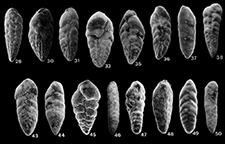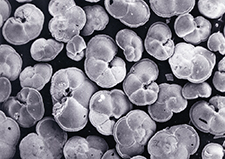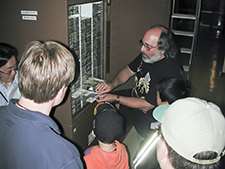



Ken Finger, a kid from New York City, was introduced to paleontology at State University of NY, Stony Brook, in the early 1970s. Wanting to do a PhD in paleo, he was accepted to the new paleobiology program at UC Davis in 1972. There he started an MA thesis on foraminifera from the active Antarctic volcano, Deception Island, which was judged by his committee to be so good that with a little more work he could turn it into a PhD dissertation. He did that, and graduated in 1976. In that same week, he got married and received a job offer as Exploration Paleontologist at Chevron USA, New Orleans. Three years later, he was promoted to Senior Research Geologist at Chevron Oil Field Research Company in La Habra, CA. While in Southern California, Ken also worked in mitigation paleontology and taught geology, paleontology, and oceanography at local colleges.
His research position at Chevron allowed him to begin his long career in publishing critical papers on microfossils. His dissertation was published in 1981 with J. H. Lipps on “Foraminiferal decimation and repopulation in an active volcanic caldera, Deception Island, Antarctica” in Micropaleontology. Ken continued his record publishing rate of at least one paper almost every year since 1981 for a total of 56 peer-reviewed papers, 4 books and scads of abstracts, mostly on foraminifera, but also on other groups of microfossils (diatoms, silicoflagellates, calcareous nanoplankton, and invertebrates: ostracods, barnacles, polychaetes, chitinozoa). His focus was not just on the fossils but on biostratigraphy, isotope geochemistry, tectonic settings and paleoenvironments. In this role, he emerged as the foremost expert on American West Coast Miocene foraminiferal biostratigraphy from Chile and north to California. Ken’s papers were well known as thorough, detailed, carefully designed, abundantly illustrated, and among the most useful of works.
From 2002 to 2017, UCMP was fortunate to have Ken (and his research programs) as Senior Museum Scientist & Manager of the extensive microfossil collection of millions of specimens and thousands of samples from all over the world. Only a truly dedicated professional micropaleontologist who’s main desire and aim was to get all the major UCMP microfossil collections in proper order so they could serve the profession and students long into the future, could deal with the massive UCMP microfossil collection. While Ken accomplished that for much of the collection, he regretfully retired without finishing all, a task he himself said would take another 100 years or so. Fortunately, Ken will remain a Museum Associate, and thus available to assist in microfossil curation and research.
Written by Jerre Lipps